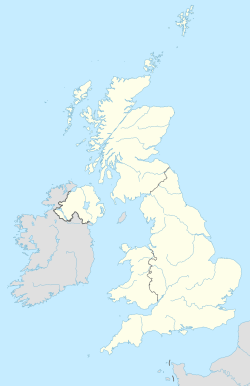Derry, Ballyphilip facts for kids
Quick facts for kids
Derry, Ballyphilip
|
|
|---|---|
|
townland
|
|
Derry is a small piece of land, called a townland, located in Northern Ireland. It's part of the civil parish of Ballyphilip and the barony of Ards Upper in County Down. You can find it close to Portaferry on the Ards Peninsula. Derry is special because it has the remains of two very old, ruined churches.
Contents
Exploring Derry's Ancient Churches
People have been using this area for religious activities for a very long time, even before the Normans arrived in Ireland. There's a story about a female saint named Saint Cumman who was connected to this place. Records show there was a chapel here as early as 1306.
These old churches are about 2.4 kilometers (1.5 miles) north-east of Portaferry. They are made from flat pieces of rock called shale slabs, held together with clay instead of modern cement. Experts believe they were built between the 10th and 12th centuries. You can find them east of the A2 road to Cloghy, on Tullymally Road, at grid reference J613 524.
The South Church: A Glimpse into the Past
The church on the south side is smaller and seems to be the older of the two. It has special wall extensions called antae at both the east and west ends. There's a door on the west side and windows on the east and south sides.
Originally, clay was used to hold the stone walls together. You can still see holes in the walls where wooden beams or scaffolding poles might have been placed during construction. Later, some changes were made to the door and the east window using mortar, which is a stronger binding material. This church might be from the 10th or 11th century, though some think it could be from the 12th century.
The North Church: Larger and Later
The north church is bigger than the south one. It was also built using clay instead of mortar. It has a door on the south side and a window on the east side. It might have even had a tower on its west end. Inside this church, you can see a small stone with an early cross carved into it. This church is probably from the 12th century or later.
There's also a grave-slab here. It has a simple Latin cross design made from two lines of three parallel grooves.
Uncovering Secrets: The 1962 Excavations
In 1962, archaeologists dug up the area around the churches. They found signs of early Christian life and a cemetery with graves built from stone, located right under the churches!
Underneath the south church, they discovered an even older building made of stone and wood. It might have been another church. This older building had drystone walls (stones fitted together without mortar) that were made stronger with wooden posts. It seems this building was built in two different stages.
During the conservation work, they carefully straightened a leaning wall of the south church. They also replaced the original clay that held the stones together. The cemetery found beneath the churches was interesting because it contained burials of men, women, and children. This was a bit surprising, as you might expect a monastery to have mostly adult male burials.


